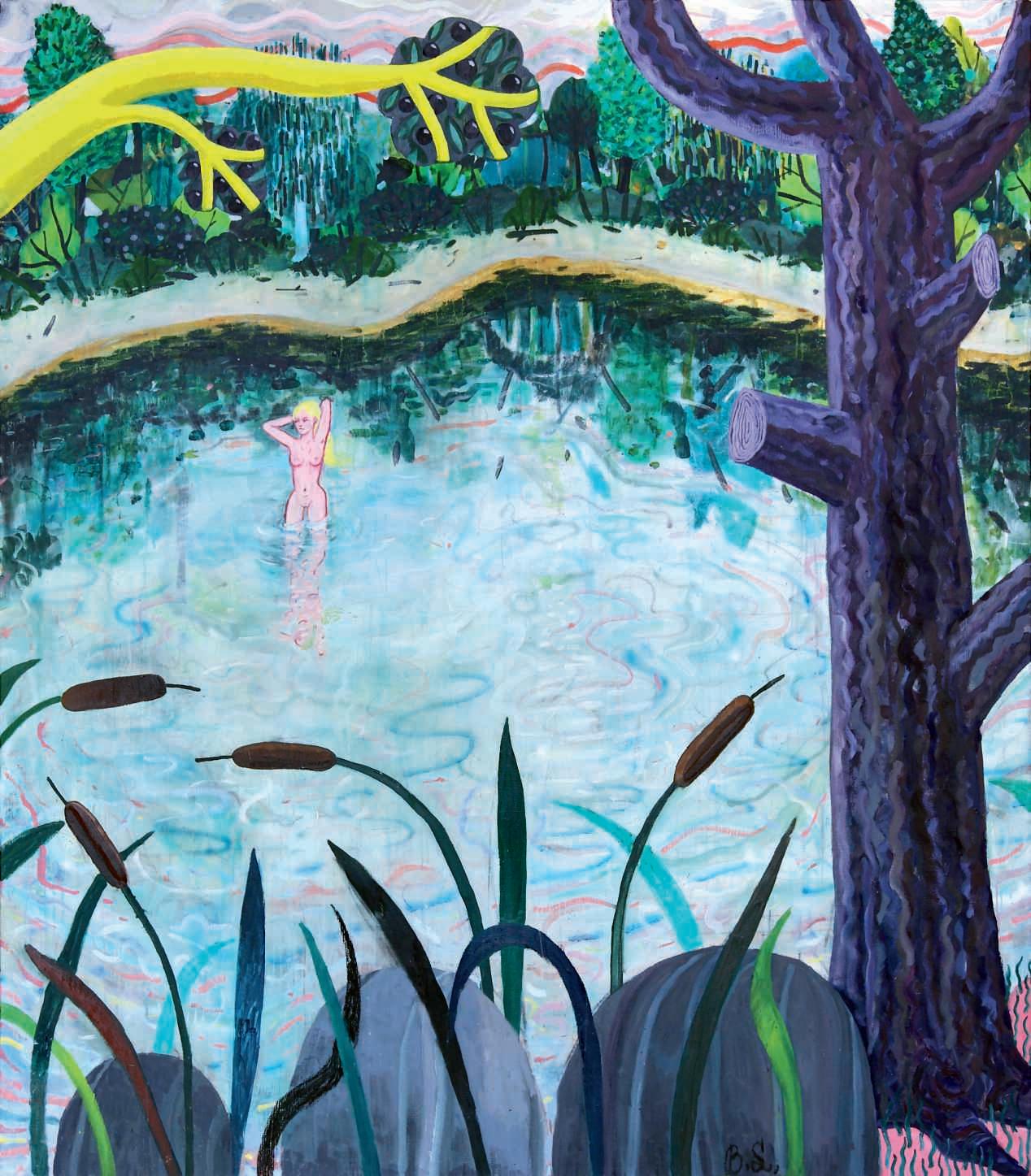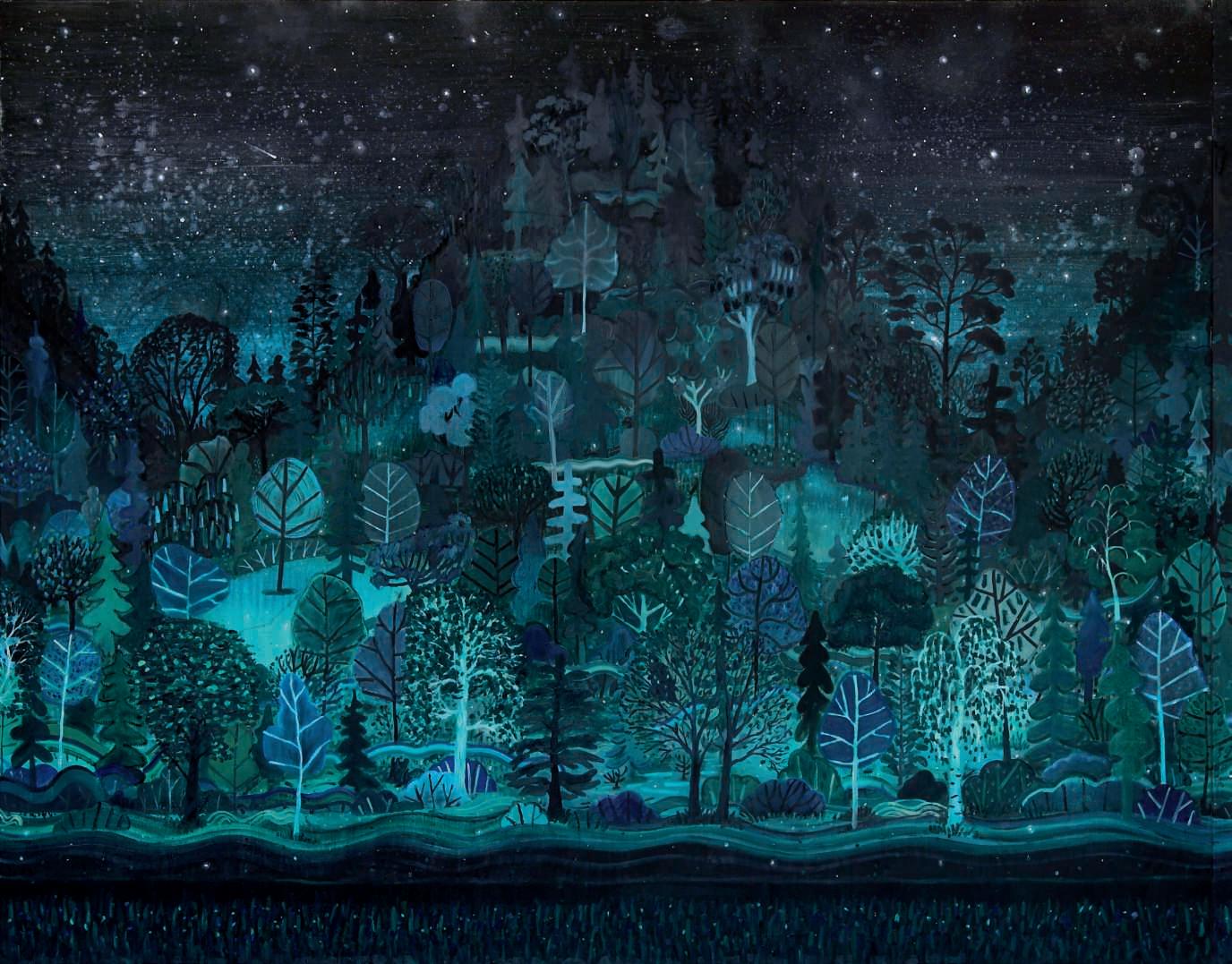
heeft de jonge Antwerpenaar immers een geheel ander idioom dan zijn illustere voorganger. Maar Sledsens kijkt goed en steelt met zijn ogen een van de belangrijkste kwaliteiten van Bruegel, en wel diens verbluffende vermogen om in een groot en complex opgebouwd landschap coherentie en structuur te behouden en het oog van de kijker door de compositie te leiden. Sledsens’ enigmatische doek Bird and Fish illustreert dat treffend, met de breugeliaanse monumentale, afgesneden boom rechts die als repoussoir diepte en reliëf geeft aan het landschap op de achtergrond – net als de uitstekende tak met contrasterend gele bloemen linksboven. Tegelijkertijd wordt zo de merel geaccentueerd, die samen met de toeschouwer naar de vis in het water kijkt – de vis die op zijn beurt de aandacht trekt, niet alleen door de pittige oranje kleur maar ook door de kringen in het water én door de ritmisch gespiegelde rietpluimen die als coulissen in een theater de blik van de toeschouwer meevoeren. Het is in die combinatie van zorgvuldige geënsceneerde en gelaagd opgebouwde composities met ritmiek, beeldrijm en beeldende spitsvondigheid dat Sledsens het werk van Bruegel de Oude in zich op lijkt te nemen. In verband met Bruegel gebruik ik regelmatig het moeilijk vertaalbare pictorial wit –een term waarin Ben Sledsens zich vermoedelijk zal vinden.
In zijn omgang met de grote meesters uit het recente en minder recente verleden is er nog iets wat opvalt: Sledsens benadert hen op een onbekommerde wijze; het gewicht van de canon van de kunstgeschiedenis lijkt niet op hem te drukken. Er is geen sprake van een nederige houding – al te vaak een teken van valse bescheidenheid. Hij staat open voor invloeden, verwerkt die, laat zich inspireren en is daar helder en eerlijk over, iets wat het hem allicht juist makkelijker maakt een eigen beeldtaal en universum te creëren. Uiteraard is het ook eigen aan deze tijd – en niet alleen in de beeldende kunsten – om te mogen en kunnen spelen met tradities en met het werk van voorgangers van allerhande soort zonder beschuldigd te worden van epigonisme of, nog erger, eclecticisme. Het is al vaker gesignaleerd dat met de (her)opleving van de figuratie in de afgelopen decennia, de schilderkunst weer aansluiting vindt bij de rijke artistieke traditie van imitatio en aemulatio: het streven om vroegere meesters na te volgen, te evenaren en zo mogelijk te overtreffen, zo kenmerkend voor de westerse kunst vanaf de vijftiende eeuw. In de kunstliteratuur van de zestiende en zeventiende eeuw wordt dat ontlenen aan andermans werk ook wel als ‘rapen’ omschreven. De invloedrijke schilder, kunstenaarsbiograaf en kunsttheoreticus Karel van Mander speelde daarmee in zijn vaak geciteerde uitdrukking ‘wel ghecoockte rapen is goe pottage (soep)’. Waarmee het ‘rapen’ dus pas echt geslaagd is als het verwerkt is tot een smaakvol eigen recept met een eigen signatuur. Deze traditie is in de loop van de negentiende eeuw onderbroken (maar nooit helemaal weg geweest) door de romantische en utopische verwachting dat een kunstenaar zonder de last van het verleden zijn volstrekt unieke en persoonlijke taal moest vinden. Een illusie, zij het wellicht een vruchtbare.
Hoezeer het ‘rapen’ ook intrinsiek deel uitmaakt van Ben Sledsens’ kunstenaarschap, het is veel meer dan dat. Zijn ‘pottage’ mag er zijn: een eigen stem, in techniek, stijl en beeldtaal. Dat alles ‘wel ghecoockt’ tot een eigen universum dat zich laat omschrijven als poëtisch en enigmatisch, want licht bevreemdend en niet eenduidig te lezen. Maar zijn werk is ook fantasievol en feestelijk, een lust voor het oog waar het schilderplezier van afspat. In dat alles doet Sledsens denken aan David Hockney – het speelse, het schijnbaar lichtvoetige, het spelen met tradities, een direct herkenbare beeldtaal en de voortdurende drang én noodzaak om te tekenen en te schilderen. Die eigen stem en eigen beeldtaal komen immers niet vanzelf. Niet-voltooide, zelfs vernietigde werken en bovenal eindeloze reeksen schetsen en tekeningen getuigen van hard werk en een lange, voortdurende zoektocht – veel meer dan je zou vermoeden als je oog in oog staat met zijn grote doeken.
Ten opzichte van zijn eerste solotentoonstelling Pulling Ropes and Ringing Bells lijkt het werk van Ben Sledsens gelaagder te zijn geworden, zowel in onderwerp als in beeldtaal. De werken die ik in het voorjaar van 2018 in zijn atelier kon zien en met de kunstenaar kon bespreken, zijn geraffineerd en complex qua beeldopbouw. Wat vooral aan kracht gewonnen heeft, is het vermogen om het oog van de toeschouwer doelbewust door de compositie te leiden zonder de coherentie van het geheel te verliezen. Sledsens heeft deze belangrijke les van Bruegel en Matisse goed begrepen.
In de afgelopen eeuw is de schilderkunst – en al helemaal de figuratieve – regelmatig doodverklaard. Je hoeft maar te kijken naar wat er in diezelfde eeuw aan kunst gemaakt is om te beseffen dat ze nooit is weggeweest. In België en internationaal leeft het meer dan ooit. In die overweldigende veelzijdigheid van beeldende kunsten laat Ben Sledsens een eigen stem horen. Een stem die veel te vertellen heeft. Een opmerkelijke en eigenzinnige stem, die nieuwsgierig maakt naar hoe ze zich verder zal ontwikkelen en welke paden bewandeld zullen worden.




14

PARADISE FOUND: THE USE OF COLOUR IN BEN SLEDSENS’ WORK
Karen Van Godtsenhoven
Should your glance on mornings lovely Lift to drink the heaven’s blue Or when sun, veiled by sirocco, Royal red sinks out of view –Give to Nature praise and honour.
Blithe of heart and sound of eye, Knowing for the world of colour
Where its broad foundations lie.
J.W. von Goethe
from: Zahme Xenien VI
Anyone taking a bird’s-eye view of Belgian painting since 1830, from Spilliaert to Tuymans, will divine a predilection for fifty shades of North Sea grey. James Ensor had already lampooned this in 1900 with his text ‘The Fleming is no longer a colourist’, in which he fulminated against the Belgian painters who were slavishly following the impressionist palette from abroad.1 His statement came more than ten years after Vincent van Gogh’s famous words from 1888: “But the painter of the future is a colourist the like of which we have not yet seen.” (letter to Theo van Gogh, Arles, 4 May 1888)2
Ensor was of the view that, since Rubens (and Memling and Van der Weyden before him), no notable individual styles had been created in a Flanders where colour usage largely followed the tone set by overseas developments, resulting in art composed of “reflections and shadows”. It is to the credit of Ensor, and of Rik Wouters a little later, that colour was ‘unleashed’ in Flemish, or rather Belgian, painting. This was one of the biggest shifts in modern art, one that would subsequently lead to the autonomous colours used by artists such as Mondrian. It was Ensor and Wouters, two Post-Impressionist colourists, who reintroduced colour; predominately primary, expressive, complementary hues such as red, blue, yellow and green. Fast forward to today, more than a hundred years on, to the panoramic, technicolour works of Ben Sledsens, who as a child
of his time (thus born long after Marcel Duchamp’s assemblages and Andy Warhol’s Campbell’s Soup) and like a veritable pickup artist, is once again adopting Ensor’s and Wouters’ riot of colour. Sledsens combines Wouters’ thematic joie de vivre with Ensor’s monumentality. His palette, with its heavy use of pink, yellow, green and purple, is softer and more romantic, thanks to the mixture of colours he employs. His range of colours gives an orientalist, almost decorative slant to the hushed, dayto-day scenes of homely conviviality. Depth and perspective are achieved through tone-on-tone colour combinations on smooth, sprawling canvases.
According to Goethe’s 1810 colour theory3 – though this is not a hypothesis in the sense of Newton’s thesis on gravity – colours are chiefly perceived via the processing of sensory stimuli of both light and dark, and not just through subjective perception based on natural laws governing the incidence of light (for example, think of the many internet discussions in 2015 about the subjective perception of the colours of ‘the dress’). In Goethe’s interpretation, white light represents good (in Sledsens’ work, the female element often has a yellow halo, which may or may not have been produced by a mass of blond hair), red and pink represent the beautiful (a pinkish red is often used to colour the skies and the backgrounds), and purple expresses restlessness, but also sophistication and decoration. Purple can therefore be seen as a superfluous colour, an ornament, which lends extra depth to that which is beautiful and good. Hence Sledsens’ work unleashes colour in a totally unique way: the frequently mixed shades become a representation of both a state of mind and of the emotional connotations of these nuances, thus taking on a symbolic stratification. A yellow bird set against a pink background looks somewhat sweeter than another of its kind set against a red background, and the use of magenta – the name of which is derived from the deep red pools of blood on the battlefield at Magenta – lends a threatening depth to a seemingly innocent scene.
Whilst we can position Sledsens as a grandson of Post-Impressionism in the Belgian colour tradition, when considered at an international level his work is more closely related to the Orientalist and Fauvist palettes of Matisse and Le Douanier Rousseau, with whom Sledsens shares both colour usage and motifs. In Sledsens’ work, green, regarded by Goethe as the most useful and restful colour, is a realistic hue whose multiple nuances portray the wonders of nature; from wild jungles and charming trees, to houseplants and the wares of a Borgerhout florist. The colour represents a certain down-to-earth quality, a sense of reality, even when depicting exotica. Sledsens’ overarching lust for life, or at times euphoric reverie, is thus often tempered by the theme of the dark forest, a ‘naive’ motif that creates a contrasting world of shadows. Just as Goethe’s teaching posits that colour is only created through the confrontation between light and darkness, as well as their combination, and that shadow is part of the light, so do Sledsens’ idyllic tableaux exist only thanks to their contrast with the dark forest. Ratio and emotion alternate in green, yellow and pink. In Sledsens’ work, we generally see the realistic scenes from everyday life depicted in primary colours (a red rear light, red roofs, a grey sky), whilst
20



32
Escaped Canary on a Branch, 2017, oil on paper, paper tape, 29,7 × 21,3 cm
Two Escaped Canaries on a Branch, 2017, oil on paper, paper tape, 29,4 × 20,7 cm

66
The Waitress, 2017, oil, acrylic and spray paint on canvas, 200 × 300 cm


86
Seven Red Flowers in a Vase, 2018, oil and acrylic on canvas, 30 × 25 cm


106
Passing Landscapes, 2015-2016, oil, acrylic, crayon and spray paint on canvas, 200 × 500 cm
























